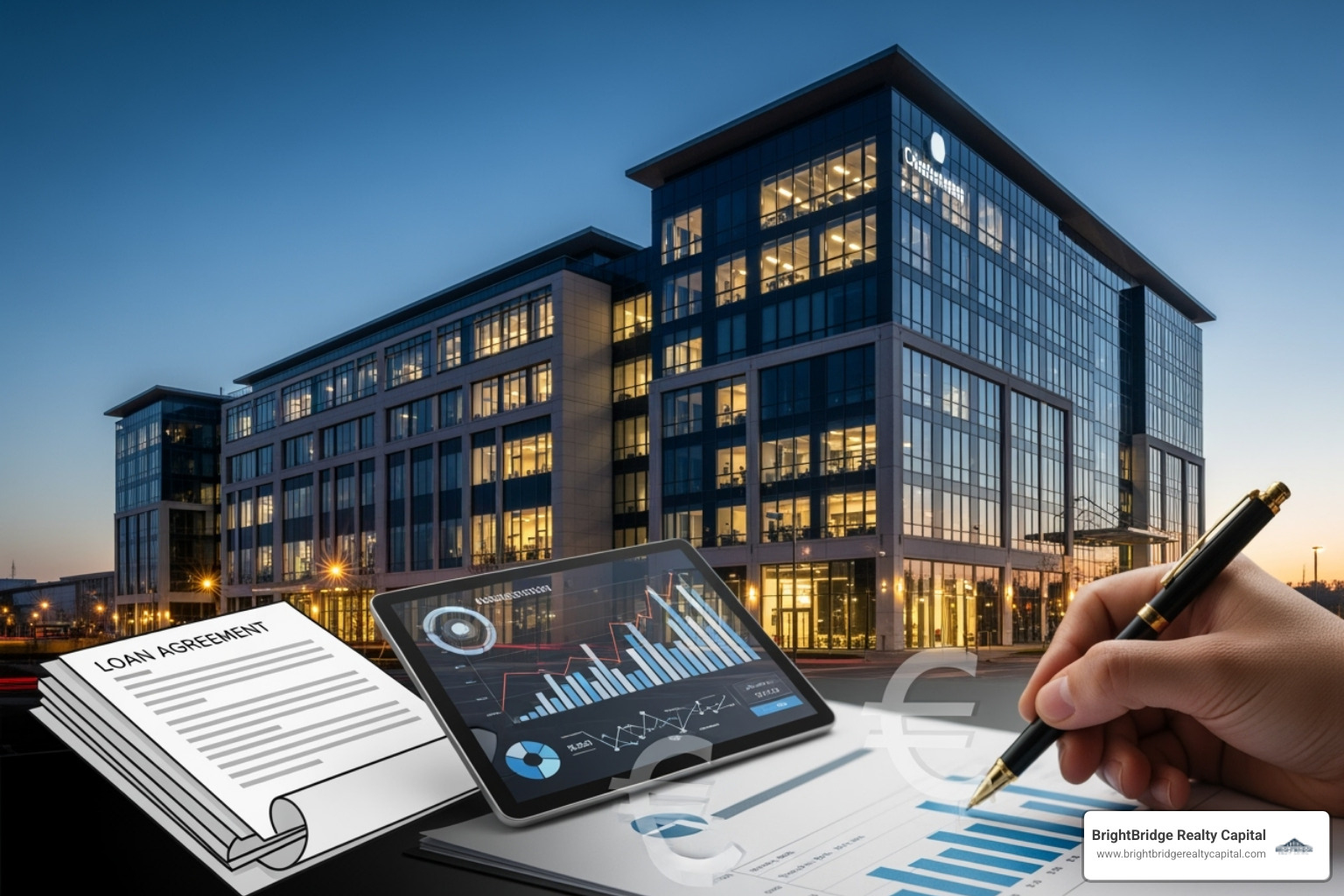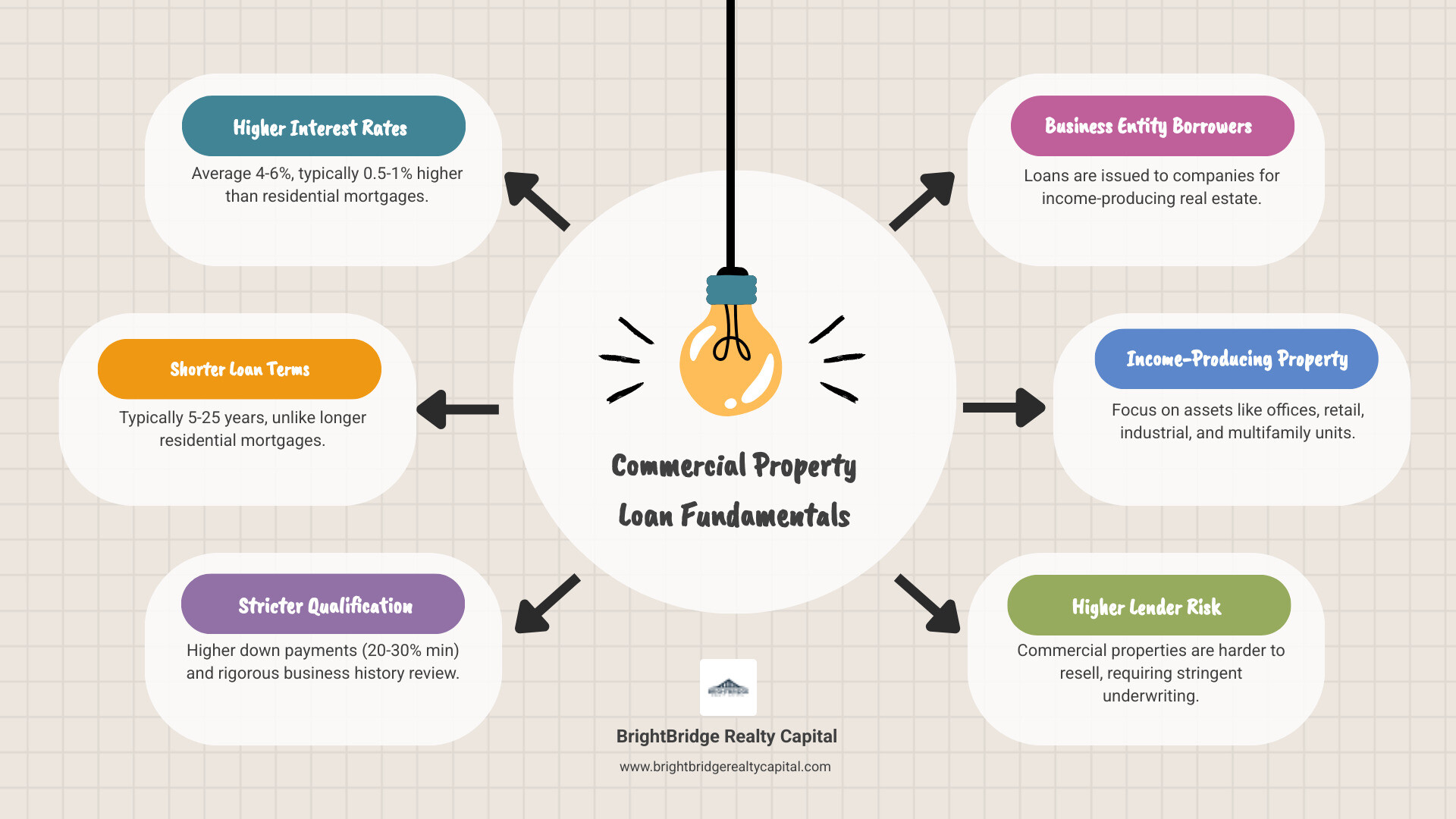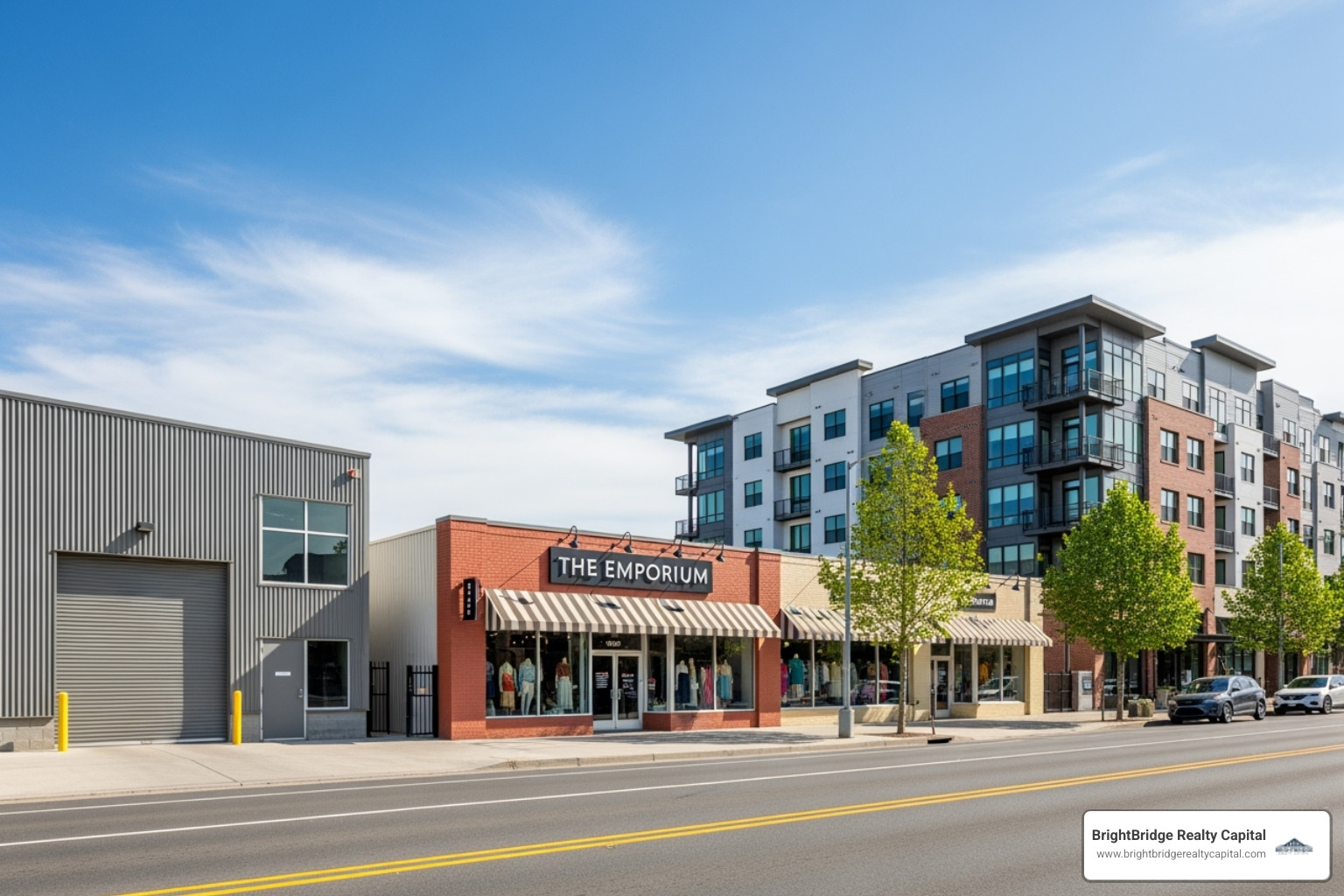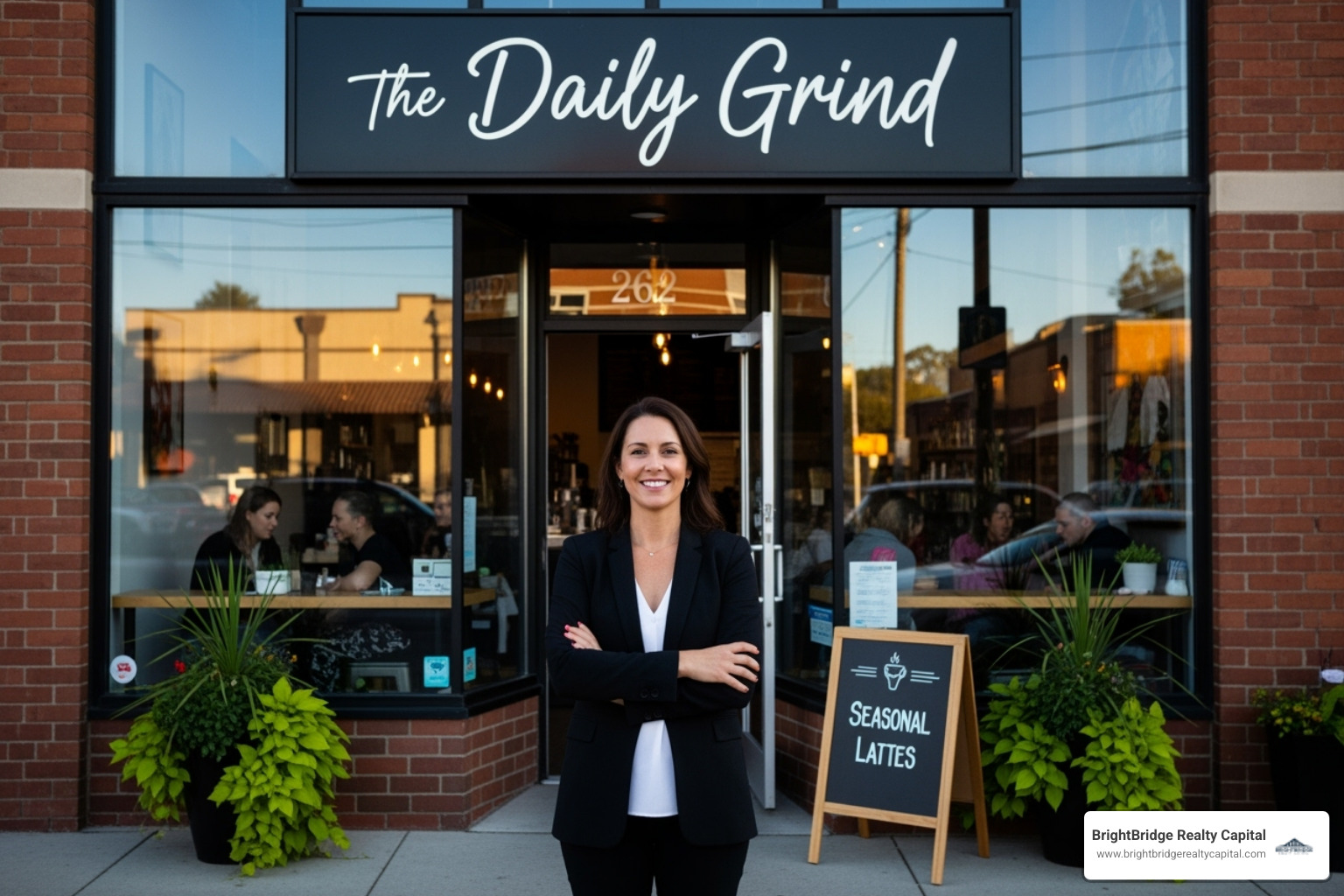The Ins and Outs of Commercial Property Loans

Understanding Commercial Property Loans for Real Estate Investors
A commercial property loan is a debt-based financing instrument used to purchase, refinance, or develop real estate intended for business purposes rather than residential use. These income-producing properties can range from office buildings and retail centers to industrial warehouses, large-scale multifamily apartment complexes, and special-purpose facilities like hotels or self-storage units. Unlike residential mortgages, which are extended to individuals, commercial loans are made to business entities such as Limited Liability Companies (LLCs), partnerships, or corporations. This structure is crucial as it helps shield the investor's personal assets from liabilities associated with the property. Lenders typically require higher down payments, often 20-30% or more, and offer shorter repayment terms, generally between 5 and 25 years, with interest rates that average between 4% and 6% but can vary significantly.
Lenders perceive commercial real estate as a higher-risk asset class compared to residential homes. This heightened risk profile stems from several factors: sensitivity to economic cycles, the potential for tenant vacancies that can disrupt cash flow, the complexities of property management, and the illiquid nature of the asset. Consequently, the underwriting process is far more stringent, focusing on the property's ability to generate sufficient income to cover the debt service and operating expenses. Despite these problems, these loans are the lifeblood for investors aiming to build substantial wealth through the acquisition and operation of income-producing properties. The lending landscape is diverse, featuring traditional banks, credit unions, private lenders, government-backed programs, and other alternative financing sources, each catering to different types of projects and investor profiles.
As a loan officer at BrightBridge Realty Capital, I've guided countless investors through the intricate commercial property loan process. Gaining a comprehensive understanding of your financing options from the outset is not just beneficial—it's critical to identifying and capitalizing on market opportunities with speed and confidence.

Commercial property loan vocab to learn:
Understanding Commercial Loans and Their Core Differences
While both residential mortgages and commercial loans facilitate the purchase of real estate, a commercial property loan operates within a fundamentally different framework. Lenders approach these transactions with a heightened sense of risk and, therefore, demand greater compensation and stricter terms, which influences every facet of the loan from application to closing.
Key Differences: Commercial Property Loan vs. Residential Mortgage
The most significant distinction is the loan's purpose and borrower type: a business entity borrows funds to acquire an income-generating asset, not an individual buying a primary residence. This core difference creates several critical distinctions:
- Higher Interest Rates: Expect commercial loan rates to be 0.5% to 1.5% higher than conforming residential mortgages. This premium compensates the lender for the increased risk associated with commercial activities, such as tenant turnover and economic volatility.
- Shorter Loan Terms: While residential mortgages commonly have 30-year terms, commercial loans typically range from 5 to 25 years. Lenders prefer shorter terms to periodically re-evaluate the risk and re-price the loan according to prevailing market conditions.
- Stricter Underwriting: The underwriting process for a commercial property loan is an in-depth analysis of the property's financial viability and the borrower's business acumen. Lenders scrutinize pro-forma statements, rent rolls, tenant lease agreements, and market analysis, placing less emphasis on personal income compared to a residential loan.
- Business vs. Individual Borrower: The loan is underwritten to a business entity (e.g., an LLC or S-Corp), which legally separates the asset from the owner's personal finances, providing a crucial layer of liability protection.
- Fewer Consumer Protections: Commercial loans are considered business transactions and are therefore exempt from many consumer protection laws that govern residential mortgages, such as the Real Estate Settlement Procedures Act (RESPA) and the Truth in Lending Act (TILA). This lack of regulatory oversight means borrowers must perform greater due diligence and often retain legal counsel to review complex loan documents.
Owner-Occupied vs. Non-Owner-Occupied (Investor) Loans
Commercial loans are further segmented based on how the property will be used:
Owner-occupied loans are designed for businesses that will purchase and occupy at least 51% of the property for their own operations. This strategy is powerful for building equity in a tangible asset rather than paying rent. It provides immense business stability by fixing location costs and eliminating the risk of a landlord not renewing a lease. Owning the property gives the business control to make necessary renovations, expand its footprint, and create a valuable asset on its balance sheet.
Non-owner-occupied investor loans are for acquiring property solely as an income generation vehicle. This category includes apartment buildings, retail centers, industrial parks, and office complexes. The primary objective is to generate positive cash flow where rental income significantly exceeds all operating expenses and debt service. This is a cornerstone of many long-term investment strategies, focusing on metrics like capitalization (cap) rate, cash-on-cash return, and net operating income (NOI). The quality of tenants and the structure of their leases (e.g., Triple Net vs. Gross) are paramount to the property's success.
Both loan categories can offer flexible loan terms and Loan-to-Value (LTV) options, with some programs reaching up to 80% for highly qualified borrowers, enabling investors and business owners to tailor financing to their specific strategic objectives.
Types of Commercial Real Estate Loans
The world of commercial property loans is not one-size-fits-all; it's a diverse ecosystem of financing options custom to different investment strategies, risk appetites, and timelines. Selecting the appropriate loan type is a foundational decision that can significantly impact the profitability and success of a real estate venture.

At BrightBridge Realty Capital, we specialize in providing flexible and fast funding, often through direct lending, to ensure you have capital when opportunity knocks.
- Traditional Bank Loans: Offered by large commercial banks and local credit unions, these are often called conventional loans. They typically feature the most competitive interest rates and longest terms, sometimes amortizing over 30 years. However, the qualification criteria are the most stringent, usually requiring a personal credit score of 700+, a strong business history (at least two years), substantial cash reserves, and a comprehensive documentation package. The approval process is also the longest, often taking 60-90 days.
- SBA Loans (7a and 504): The Small Business Administration (SBA) partially guarantees these loans, reducing the risk for lenders. This allows for higher LTVs (lower down payments, sometimes as low as 10%) and longer repayment terms. SBA 504 loans are specifically for major fixed assets like real estate, while 7(a) loans are more versatile. They are excellent for owner-occupied properties but involve a significant amount of paperwork and a lengthy approval timeline.
- Private Commercial Loans: Sourced from private investors, debt funds, or non-bank financial institutions, these loans are defined by their flexible underwriting. Lenders focus more on the asset's value and income potential rather than the borrower's credit history. This makes them a powerful tool for financing unique properties, value-add projects, or for borrowers who don't meet the rigid criteria of traditional banks. Rates are higher to compensate for the increased risk.
- Bridge Loans: These are short-term financing solutions (typically 6 months to 3 years) designed for speed and temporary funding. They are ideal for acquiring a property quickly, financing renovations on a distressed asset, or “bridging” the gap until the property is stabilized and can qualify for permanent, long-term financing. Bridge loans offer fast payouts but have higher interest rates and fees due to their short-term nature. More info about bridge loans
- Construction Loans: Used to finance the ground-up construction of a new building or a major renovation of an existing one. These loans are structured to disburse funds in stages (draws) as construction milestones are met. They are typically interest-only during the construction phase. Once construction is complete and the property receives a certificate of occupancy, the loan is usually refinanced into a permanent commercial property loan, often called a “takeout loan.” More info about construction financing
Comparing Commercial Loan Options
This table highlights the key differences between common loan types:
| Loan Type | Average Interest Rate | Average LTV Ratio | Typical Maximum Term | Key Characteristics |
|---|---|---|---|---|
| Traditional Bank | 4.2%–8% | 70%–80% | 30 years | Strictest requirements, lower rates, longer terms. Best for stabilized properties and strong borrowers. |
| SBA Loan | Varies (often Prime +) | 85%–90% | 25 years | Lower down payment, long terms. For owner-occupied properties. Lengthy process. |
| Private | 6%–12% | 65%–80% | 5-30 years | Flexible qualification, custom solutions. Good for value-add projects or non-standard borrowers. |
| Bridge Loan | 9%–13% | 80%–90% | 1-3 years | Fast closing, short-term, higher rates. Used to acquire or reposition assets before long-term financing. |
| Construction | Varies | Varies | Project-specific | Funds disbursed in draws, interest-only during construction. Converts to a permanent loan. |
As a direct lender, BrightBridge offers flexible qualification standards and custom solutions for both owner-occupancy and investment opportunities, with loan-to-value options up to 80%. For current information, see our official loan program rates and terms.
Navigating Rates, Terms, and Fees
Successfully financing a commercial property requires a deep understanding of not just the loan amount, but the intricate details of its cost structure. The interest rate, loan term, amortization schedule, and associated fees collectively determine the true cost of borrowing and are essential for accurately projecting an investment's profitability.
What are the Typical Rates for a Commercial Property Loan?
Currently, commercial property loan rates generally average between 4% and 6% for conventional financing, though this can fluctuate significantly based on economic conditions and the specific deal. Rates are typically tied to benchmark indexes like the Prime Rate or the Secured Overnight Financing Rate (SOFR), which has largely replaced LIBOR. Lenders quote rates as a spread over the index (e.g., SOFR + 300 basis points). You will encounter two primary rate structures:
- Fixed rates: The interest rate is locked in for the entire loan term (or a portion of it), providing predictable monthly payments and protecting against rising rates.
- Variable rates: Also known as floating rates, these fluctuate with the underlying market index. They may start lower than fixed rates but introduce uncertainty and risk if rates increase.
Your specific rate is a product of the lender's risk assessment, which is heavily influenced by the loan-to-value (LTV) ratio, your personal and business credit history, your experience level, and the property type. Lenders categorize properties by risk; for example, a stabilized multifamily apartment complex is generally considered lower risk than a hotel or a special-purpose building like a movie theater, and will therefore command a more favorable interest rate.
Common Loan Terms and Potential Fees
Beyond the interest rate, you must analyze these critical components:
- Loan Term: This is the period over which you are contracted to repay the loan, typically ranging from 5 to 25 years. It is often shorter than the amortization period.
- Amortization: This is the schedule of principal and interest payments used to pay off the loan over a longer period, such as 25 or 30 years. When the loan term is shorter than the amortization period (e.g., a 10-year term with a 25-year amortization), your monthly payments are lower, but this structure results in a large balloon payment—the entire remaining loan balance—being due when the loan term expires. This introduces significant refinancing risk.
- Prepayment Penalties: Many commercial loans include penalties for paying off the loan early, as lenders want to protect their expected yield. Common structures include yield maintenance (a complex calculation requiring the borrower to compensate the lender for lost interest) and defeasance (where the borrower must replace the loan's cash flow with a portfolio of government securities). A simpler alternative is a step-down penalty, which decreases over time (e.g., 5% of the balance in year one, 4% in year two, etc.).
- Other Fees: Be prepared for a variety of closing costs. These almost always include an origination fee (typically 0.5% to 1.5% of the loan amount), an appraisal fee for a detailed commercial valuation, title insurance, legal fees for both your counsel and the lender's, and costs for third-party reports like a property survey and a Phase I Environmental Site Assessment.
At BrightBridge Realty Capital, we prioritize transparency. We ensure you understand every line item in your term sheet, so you can make fully informed decisions about your investment strategy without hidden costs or surprises.
The Commercial Property Loan Application and Approval Process
Securing a commercial property loan is a meticulous process that is significantly smoother when you are well-prepared and understand the lender's perspective. Unlike residential lending, where the focus is on personal income, commercial underwriting is a deep dive into the property's economic viability and the borrower's capacity to operate it successfully.

A Step-by-Step Guide to the Loan Process
- Pre-Qualification and Initial Diligence: The process begins with an initial conversation with a lender to discuss the project's scope and determine basic eligibility.
- Formal Application: The borrower submits a comprehensive loan application along with a detailed package of required documentation.
- Underwriting: The lender's team performs a thorough analysis of the borrower's financials and the property's projected performance. This is the most intensive phase, where third-party reports (appraisal, environmental) are ordered.
- Term Sheet and Commitment: If the initial underwriting is positive, the lender issues a term sheet outlining the proposed loan terms. Upon acceptance, this is followed by a formal loan commitment letter.
- Closing: Attorneys for both sides draft and negotiate the final loan documents. Once all conditions are met and documents are signed, the loan is funded.
How Lenders Evaluate Your Application
Lenders assess risk by scrutinizing several key factors:
- Credit Score: While alternative lenders are more flexible, traditional banks prefer a personal FICO score of 700 or higher from the guarantors.
- Business History & Revenue: Lenders look for stability, typically requiring at least two years of operating history and consistent annual revenues (often over $250,000 for conventional loans).
- Loan-to-Value (LTV) Ratio: This measures the loan amount against the property's appraised value. Most lenders will finance 70-80% LTV, meaning the borrower must contribute a 20-30% down payment.
- Debt Service Coverage Ratio (DSCR): This is a critical metric in commercial lending. It is calculated by dividing the property's Net Operating Income (NOI) by its total annual debt service. Lenders require a DSCR of at least 1.25x, which indicates the property generates 25% more income than is needed to cover the mortgage payments, providing a necessary cash flow cushion.
- Collateral Quality: The property's physical condition, location, tenant quality, and lease terms are heavily scrutinized. A prime property with long-term, creditworthy tenants is considered high-quality collateral.
- Personal Guarantees: It is standard practice for the primary owners of the business to be required to personally guarantee the loan. This means if the business entity defaults, the lender can pursue the owner's personal assets for repayment.
Preparing Your Finances for a Successful Application
A carefully prepared application package demonstrates professionalism and inspires lender confidence. Be ready to provide:
- Business Plan: A comprehensive document outlining your executive summary, market analysis, management team, and detailed financial projections for the property.
- Financial Documents: Three years of business and personal tax returns, current year-to-date financial statements (profit & loss, balance sheet), and bank statements.
- Property Details: A copy of the purchase agreement, a detailed rent roll showing all current tenants and lease terms, and copies of existing leases.
- Cash Reserves: Proof of sufficient liquid assets to cover the down payment, closing costs, and several months of mortgage payments.
- Debt Schedule: A complete list of all outstanding business and personal debts.
At BrightBridge Realty Capital, our streamlined process is designed for efficiency, focusing on your property's potential and your overall investment strategy. This approach often allows us to close loans in a week or less, a critical advantage in a competitive market.
Strategic Considerations for Borrowers
Starting on the path to secure a commercial property loan is a significant strategic move that can define the trajectory of a business or investment portfolio. A clear-eyed assessment of the profound advantages and inherent challenges is essential for long-term success.

Advantages and Disadvantages of Commercial Property Ownership
The primary advantages of owning commercial real estate are substantial. They include building equity as the loan is paid down and the property appreciates, gaining control and stability for your business operations, generating consistent income from tenants, and accessing powerful tax benefits. Key tax advantages include deducting mortgage interest and property taxes, and most importantly, claiming depreciation—a non-cash expense that can shelter a significant portion of your income from taxes. Furthermore, leverage (using borrowed capital) can amplify returns on your initial cash investment, and a 1031 exchange can allow you to defer capital gains taxes when selling.
However, investors must be prepared for the disadvantages. Commercial property loans inherently involve higher costs and risks. The upfront costs (down payment, closing fees) are significant, and the shorter terms can lead to larger monthly payments. The application and management processes are far more complex than residential real estate, often requiring a team of professionals including attorneys, accountants, and commercial real estate agents. Properties are also subject to market fluctuations; an economic downturn can lead to higher vacancies and reduced cash flow. Finally, commercial real estate is an illiquid asset, meaning it cannot be quickly converted to cash without a substantial loss in value.
The Role of a Loan Broker vs. a Direct Lender
When seeking a commercial property loan, you have two primary channels: working with a loan broker or approaching a direct lender.
Loan Brokers act as intermediaries. Their value lies in their extensive network of lending institutions. They can be particularly helpful for borrowers with complex or unusual financing needs, as they have the market knowledge to match the deal with the right niche lender. They manage the application process and can sometimes negotiate better terms on your behalf. The downside is that this can add a layer of communication, potentially slowing the process, and they are compensated with a fee that is either paid by the borrower or the lender.
Direct Lenders, like BrightBridge Realty Capital, are the source of the capital. You work directly with the institution that is underwriting and funding your loan. This approach eliminates the intermediary, leading to faster decisions, clearer communication, and greater transparency and certainty of execution. Our direct lending model is a significant advantage for time-sensitive transactions or for deals that require creative, flexible solutions that don't fit neatly into traditional lending boxes. While a direct lender's product suite may be more focused than the entire market a broker can access, the speed and reliability they offer are often paramount.
The most important factor is finding a financing partner who deeply understands your strategic goals and has the capability to deliver the right capital solution with speed and flexibility.
Frequently Asked Questions about Commercial Property Loans
Here are detailed answers to some of the most common questions we encounter from investors and business owners exploring commercial property loans.
How much of a down payment is needed for a commercial property?
The down payment, or equity injection, is typically larger for commercial properties than for residential homes. The required amount varies by loan type and the perceived risk of the deal:
- Traditional Bank Loans: Expect to put down 20% to 30%. A 25% down payment (75% LTV) is a common benchmark.
- SBA Loans: These are a major exception. Because of the government guarantee that reduces the lender's risk, down payments can be as low as 10% for certain 504 and 7(a) loan programs.
- Hard Money and Bridge Loans: The LTV for these loans is highly dependent on the specific deal, but they are often asset-focused. While some may go up to 90% LTV for a purchase and renovation (Loan-to-Cost), a down payment of 25% to 40% of the as-is value is common.A larger down payment always strengthens an application, as it reduces the lender's risk and demonstrates your commitment to the project, which can help you secure more favorable rates and terms.
Can I get a commercial loan with bad credit?
Yes, obtaining a commercial property loan with a less-than-perfect credit history is possible, but your options will shift away from traditional banks. While major banks typically require a FICO score of 700 or higher, many other lenders place a greater emphasis on the property's strength.
Hard money and private lenders are asset-based lenders. Their primary underwriting focus is on the collateral—the property's value, its potential for income generation, and your business plan to realize that potential. A compelling deal with strong cash flow or a clear value-add strategy can often overcome a lower credit score or past financial blemishes. At BrightBridge Realty Capital, we look at the complete picture and can provide financing up to 75% of the property's value, focusing on the asset's merits rather than solely on credit history.
How long does it take to get a commercial property loan?
The timeline from application to funding varies dramatically depending on the lender type:
- Traditional Banks & SBA Loans: These are the slowest channels due to their multi-layered bureaucracy, committee approvals, and extensive due diligence. Expect the process to take 60 to 90 days, and sometimes even longer.
- Bridge & Hard Money Loans: These lenders are built for speed. Because they are direct lenders with streamlined underwriting and in-house decision-making, they can often close in as little as 7 to 14 business days. This speed is a major competitive advantage in real estate.At BrightBridge Realty Capital, our direct lending model is optimized for efficiency. We understand that opportunities are time-sensitive, which is why we frequently close loans in 10 days or less. Your level of preparation is also a key factor—having all your financial documents organized and ready can significantly accelerate any loan process.
What are the main categories of commercial property?
Commercial real estate is a broad term covering several distinct property types, each with its own risk profile:
- Multifamily: Apartment buildings with five or more units. They are often considered a stable asset class due to the consistent demand for housing.
- Office: Ranges from single-tenant buildings to high-rise towers. Performance is closely tied to employment growth and corporate expansion.
- Retail: Includes strip malls, shopping centers, and individual storefronts. Success is dependent on tenant strength and consumer spending.
- Industrial: Warehouses, distribution centers, and manufacturing facilities. This sector has seen immense growth due to e-commerce.
- Hospitality: Hotels and motels. These are operating businesses as much as real estate, making them highly sensitive to economic trends and travel.
- Special Purpose: A catch-all for properties with a unique use, such as self-storage facilities, car washes, or medical clinics. They require specialized lender knowledge.
Conclusion
Navigating commercial property loans is a complex but essential skill for any serious real estate investor or business owner. While the underwriting standards are undeniably more rigorous and the terms more complex than those of residential mortgages, the rewards are profound. The right commercial loan is a powerful tool for building generational equity, generating durable passive income, and achieving strategic business growth.
Your success in this arena hinges on two key pillars: meticulous preparation and strategic partnership. The journey involves understanding the fundamental differences between loan types, from slow-and-steady traditional bank loans to the rapid and flexible solutions offered by bridge and private lenders. It requires a deep dive into the nuances of rates, terms, and fees, and the disciplined assembly of a flawless application package. This thorough due diligence is the foundation upon which successful financing is built.
Equally important is choosing the right financing partner—one who not only provides capital but also understands your vision and can execute with the speed and flexibility your strategy demands. At BrightBridge Realty Capital, our entire model is built around this principle. Our focus on fast closings and flexible solutions ensures you have a reliable partner who can move at the speed of your business, because we know that in the competitive landscape of real estate, timing is everything.
Whether you're a seasoned investor executing a time-sensitive 1031 exchange, a business owner ready to secure your operational future by purchasing a building, or a developer seeking capital for a new project, the right financing is the bedrock of your success. Ready to take the next step? For flexible and fast financing solutions custom to your real estate investment needs, explore our DSCR rental loan programs. We're here to bridge the gap between your real estate goals and their achievement.


